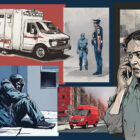This article is adapted from an episode of our podcast “Civic,” which revisits a 2019 interview with Julia Flynn Siler and a site visit to the Cameron House. Click the audio player below to hear the full story, and hear the extended versions here.
In the basement of a large community center in Chinatown, you can still find the entrance to tunnels that rescued women and girls would use to escape traffickers who had tailed them to this former safe house. In the late 1800s, Chinese women and girls were arriving by the boatload in San Francisco, and often forced into sex work and indentured servitude while officials turned a blind eye, or even enabled the practice. A group of women began to rescue them through what came to be known as the Cameron House.
Today, the Cameron House carries on that legacy as a Presbyterian multiservice agency, offering everything from youth development programs to English classes to empowerment training for domestic violence survivors. Journalist Julia Flynn Siler tells this story in her book “The White Devil’s Daughters: The Women Who Fought Slavery in San Francisco’s Chinatown.”
“This was an extremely hostile time to the Chinese and especially to Chinese women,” Siler said. “These white middle class church women were defying their husbands, were defying the ministers of the church who didn’t really like this project very much, and going ahead.”
The Cameron House, under the leadership of its namesake Donaldina Cameron, offered refuge but also enforced a strict schedule and religious education, all in an atmosphere of constant vigilance.
“Everyone would do chores. There would be prayers every morning. There was education. In some cases, these girls and women — this is the first formal education they ever got,” Siler said. “On Sundays they would go to church and they would be escorted from the home to church because of the fear that traffickers would try to snatch them back off the streets.”
One woman, Tien Fuh Wu, who arrived at the Cameron House after being rescued from trafficking and abuse, eventually took on a key role in running the center.
“It’s very important to note that the superintendents of the home generally did not speak Chinese. So, she was the intermediary between the white women who ran and financed this home and the girls and women who took refuge there,” Siler said.
Wu and Cameron ultimately became close friends and collaborators.
After Cameron’s retirement, the history of the house entered a period of hidden, silent abuse. Cameron’s successor, Dick Wichman, is accused by more than a dozen people of having sexually assaulted and abused them in their youth. The Cameron House, religious leaders in the local Presbyterian Church, survivors and their loved ones began a healing process and created a documentary about it this year. Siler also investigated the allegations in a story for Alta Journal.
A segment from our radio show and podcast, “Civic.” Listen at 8 a.m. and 6 p.m. Tuesdays and Thursdays at 102.5 FM in San Francisco, or online at ksfp.fm, and subscribe on Apple, Google, Spotify or Stitcher.










